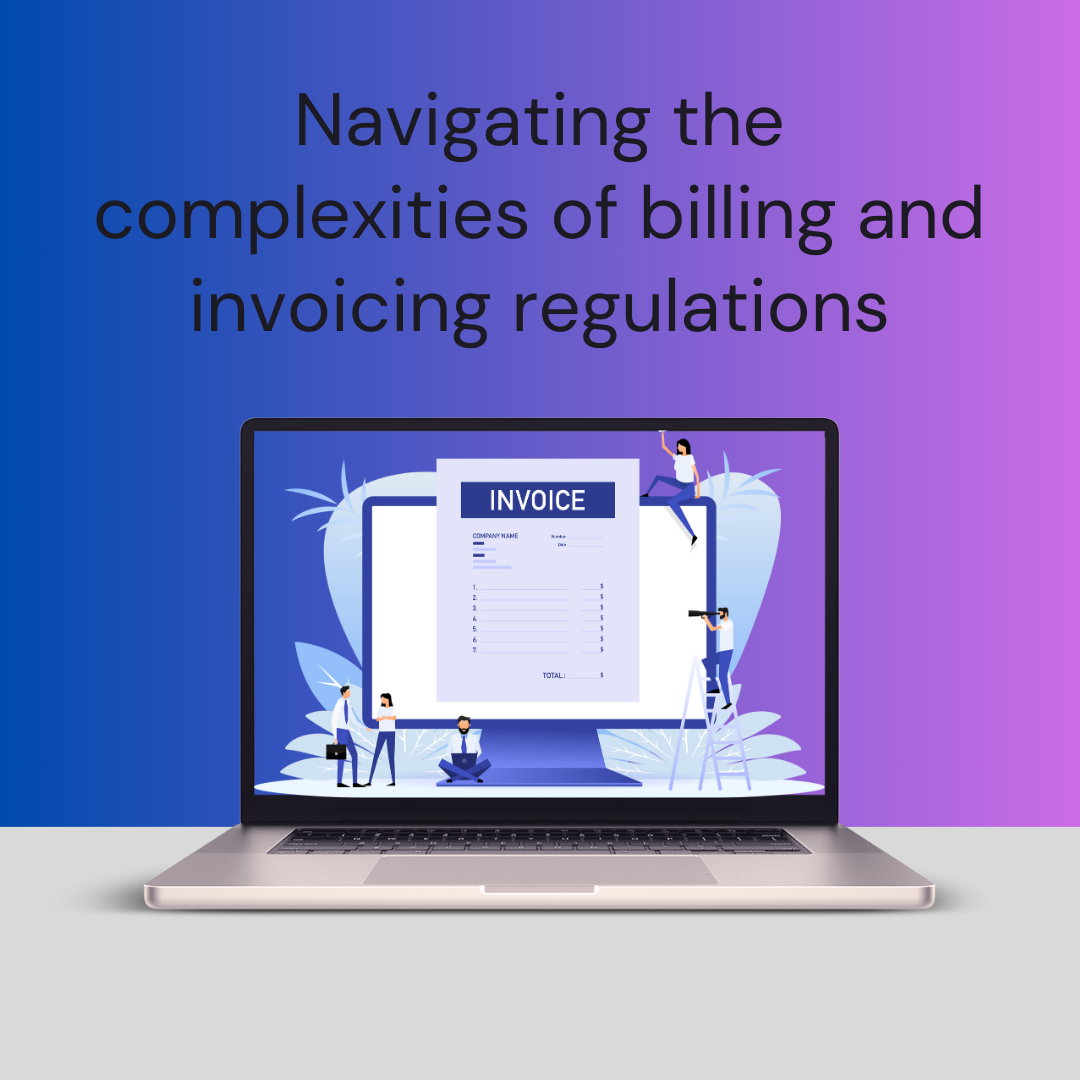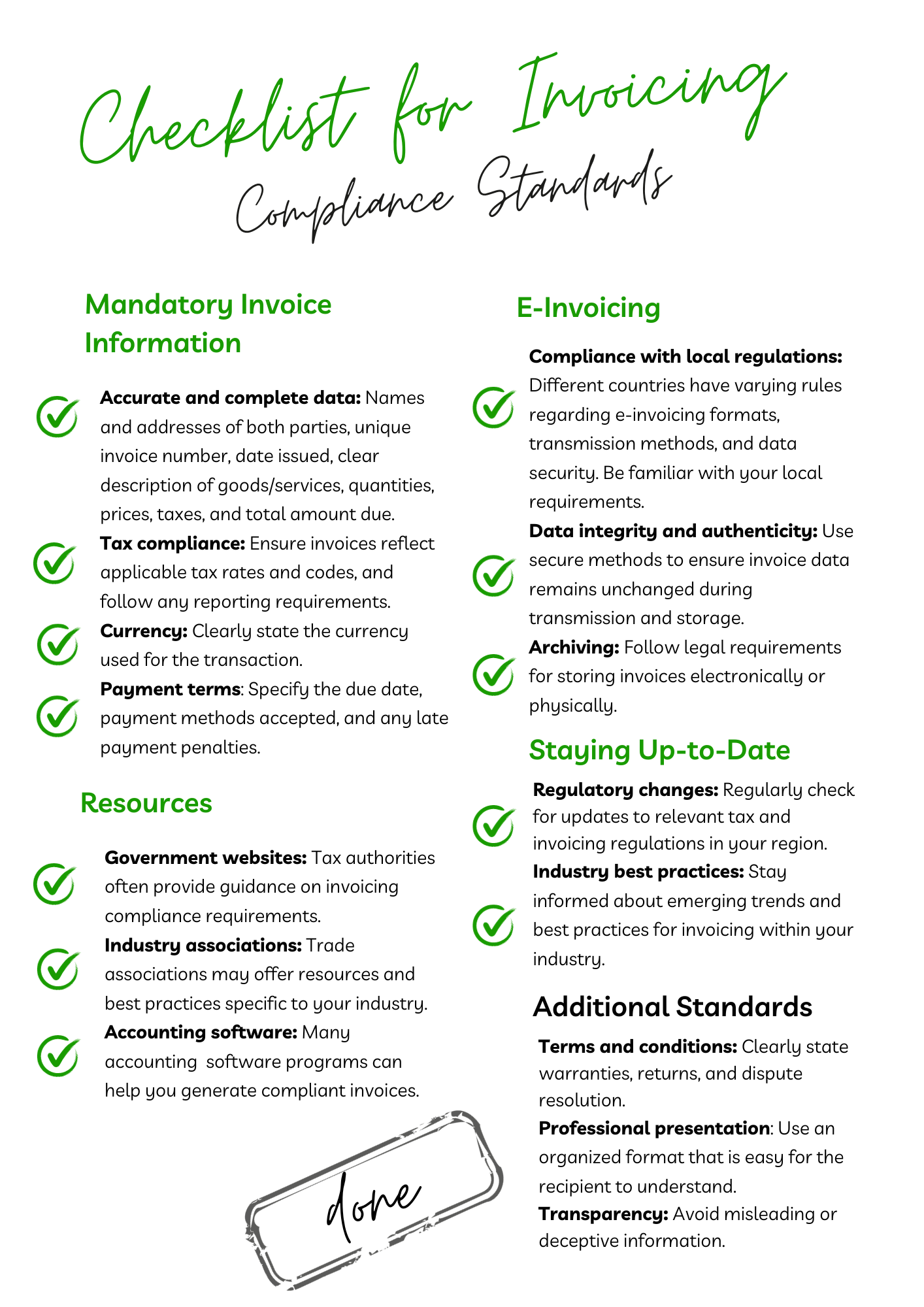How to Navigate the Regulatory Landscape of Billing and Invoicing
Navigating the regulatory landscape of billing and invoicing can be challenging. Learn about the key regulations, best practices, and tools to ensure compliance and streamline your invoicing and billing processes.

Managing billing and invoicing is crucial for the financial wellbeing of every business.
However, dealing with complicated regulations and securing prompt payments can be a tough task because sending an invoice (a task that might appear straightforward) can actually involve complex international requirements.
From tax requirements to data privacy laws, these requirements build an intricate web🕸️
Hence, with various industries and regions varying in regulations and standards, it is worth knowing what processes govern how invoices are:
- created
- presented
- processed.
Why It Is Important: Not only is efficient invoicing vital for the smooth operation of a business, but it also plays a key role in adhering to compliance standards, ensuring transparency, and building trust with customers.
Below, we list key factors and tips to regard and help you comply with invoice and billing regulations.
Types of Regulations in Invoicing and Billing

Industry-Specific Regulations
Industry-specific regulations determine the choice of invoicing practices because different sectors have their own distinct rules and requirements for issuing and managing invoices.
The Department of Regulatory Agencies (DORA) is an example of an agency charged with control over licensing and registration for multiple professions and businesses, which was established to implement balanced regulation for industries and protect consumers.
As a result, healthcare providers, for instance, must adhere to complex billing regulations set by insurance companies and government programs like Medicare and Medicaid, including the usage of specific coding for diagnoses and treatments, documentation requirements, and rules for submitting claims.
Regulations like HIPAA in the United States mandate strict confidentiality and handling of patient information, including in billing.
Lawyers must follow ethical guidelines regarding billing practices, including transparency and fairness in billing clients. This often means providing invoices that break down charging for services in a highly detailed manner.
Telecom companies are often subject to regulations that dictate how they can bill customers, including rules about transparent pricing and the provision of customer service.
Regulations often govern how banks and financial institutions can charge interest and fees to ensure fairness and transparency for consumers as well as to protect consumers from predatory lending practices and misleading financial products.
Regional Standards
Regional variations in invoicing practices are not uncommon.
For instance, within the European Union, there are regulations governing invoicing, such as the requirement to include VAT (Value Added Tax) information on invoices.
Another example refers to invoices in Australia that must comply with Goods and Services Tax (GST) requirements that dictate including the seller's identity and Australian Business Number (ABN), a description of the goods or services, the date of the invoice, the amount of GST, and the total amount payable in the invoice.
The Bottom Line: Think of those invoices as passports for your business. Making sure they're stamped and approved in the right places (tax laws, data privacy, you name it) doesn't just keep you legal and prevents penalties; it shows clients and partners you're a smooth operator who can navigate any business jungle.
Standardization
Many countries and industries have implemented standardized invoicing formats to streamline the invoicing process and improve efficiency.
These standardized formats typically consist of specific fields and requirements for presenting invoice information.
Electronic Invoicing
The rise of electronic invoicing (e-invoicing) has also brought about new regulations and standards. E-invoicing systems have specific requirements for:
- Data security
- Electronic signatures
- Data formats.
Taxation
Invoicing regulations often include guidelines related to taxation:
- Tax identification numbers
- Accurate calculation of taxes.
The applicable tax rate(s) should be specified, and the corresponding tax amount should be calculated and displayed.
In some regions, there could be a mandatory specific wording required by tax authorities.
For instance, within the EU, if goods or services are not subject to VAT, the invoice must clearly indicate the specific reason for this exemption. As an example, "VAT Exempt - Article 44 of the VAT Directive".
Dispute Resolution
Some regulations also address dispute resolution mechanisms related to invoicing, outlining processes for handling disputes and ensuring fair resolution.
Thus, navigating the regulatory framework for billing and invoicing requires a clear understanding and adherence to the various laws as well as international and local guidelines that dictate these processes.
This approach aims to achieve several key objectives:
- Ensured compliance with legal requirements
- Maintenance of accurate and precise records
- Transparency in dealings with customers and regulatory authorities.
Key Steps in Invoicing and Billing

In Global Invoicing, Comply with Local Laws
- If operating internationally, be aware of the laws in each country you do business with. It may involve registering for taxes in those jurisdictions, charging the correct tax rates, and following local invoicing requirements.
- As mentioned above, regulations can vary significantly depending on the region. For example, in the European Union, VAT rules are essential for billing, whereas in the United States, state-specific sales tax laws are more relevant.
- Invoicing clients in their local currency and language can significantly reduce misunderstandings and compliance issues. Use invoicing software that supports multi-currency transactions and allows for customization of invoice language to match the client’s preference.
- Establish internal procedures or use external services to regularly audit your invoicing processes. This can help in identifying and rectifying any non-compliance issues early.
- When in doubt, consult with legal experts in the respective countries. They can provide guidance specific to your business operations and help navigate complex legal landscapes. This is particularly important for businesses that operate in multiple countries with diverse legal requirements.
Ensure Understanding of Contractual Obligations
- Before drafting invoices, it's vital to thoroughly review and understand the contractual agreements related to the transaction. This includes payment terms, timelines, penalties for late payments, and any specific billing procedures agreed upon.
- Maintain open and regular communication with clients or business partners regarding invoicing and billing. This ensures both parties have a mutual understanding of the terms.
- Ensure that your team, especially those handling invoicing and billing, is well-trained and understands the contractual obligations. Regular training sessions can help keep them updated on any changes in contract terms or billing procedures.
- Conduct regular audits of your invoicing and billing processes to ensure they are in line with contractual obligations. Compliance checks can identify and rectify any deviations from the agreed terms.
- Have clear protocols for handling disputes or misunderstandings related to invoicing and billing. This should be part of the contractual agreement and can include steps like mediation or arbitration.
Maintain Transparency and Accuracy
- Ensure that all invoices are clear, accurate, and contain all necessary information.
- Check requirements for e-invoicing: with the rise of digital transactions, many countries have specific regulations for electronic invoicing.
- Invoices should be detailed and aligned strictly with the terms of the contract. You need to itemize all charges and reference specific contract clauses to create transparency and, in this way, prevent disputes and confusion.
- Keep detailed records of all contracts, communication, invoices, and payments. This is crucial for reference in case of any discrepancies or disputes. It also helps in auditing and compliance purposes.
- Utilize invoicing templates and deploy billing software that can be customized to align with specific contract terms, thereby reducing manual errors and ensuring consistency.
Use Standardized Software
Companies that have fully automated their electronic invoicing systems can enjoy the efficiencies of digital processes by achieving faster payment receipts and expedited payments to their suppliers.
Features to consider for clear invoicing
- Professional templates: Pre-designed templates ensure consistent formatting and avoid confusion
- Itemization: Detailed descriptions and clear pricing prevent ambiguity about charges
- Tax calculations: Automated tax calculations eliminate errors and simplify compliance
- Payment gateway integration: Accept payments directly through the software for faster processing
- Notes and comments: Provide additional context and clarify specific details
- Revision history: Track changes made to invoices for transparency and accountability.
Choose among the best invoicing software presenting these features at best.
Freelancers and Small Businesses
FreshBooks: User-friendly interface, customizable templates, automatic reminders, mobile app.
Zoho Invoice: Free plan available, detailed reports, payment gateway integration, and project tracking.
Wave: Simple and free for basic invoicing, including estimates and receipt creation.
Medium-Sized Businesses
Bill.com: Advanced features like recurring invoices, payment processing, and automated workflows.
Xero: Comprehensive accounting solution with strong invoicing capabilities, inventory management, and payroll.
QuickBooks: Robust scalability for larger businesses, flexible customization options, and integrations with other software.
Enterprise-Level
NetSuite: Cloud-based ERP system with powerful invoicing features, real-time reporting, and global capabilities.
SAP Business One: Comprehensive business management suite with integrated invoicing, CRM, and supply chain management.
Oracle ERP Cloud: Highly scalable and customizable for complex business needs, advanced invoicing with approval workflows.
Benefits of AI-Powered Invoicing and Billing Solutions
Identifying compliance issues: AI software can analyze extracted data against relevant regulations and highlight potential compliance issues. This could involve flagging missing mandatory information, incorrect tax rates, or violations of specific billing practices.
Proactive error detection: AI can identify inconsistencies and discrepancies within invoices and bills, as well as deviations from typical patterns, and prevent incorrect pricing, miscalculations, and duplicate charges.
Real-time guidance and recommendations: AI-powered solutions provide real-time guidance to users on specific regulations and suggest corrective actions for identified issues.
Automated compliance reporting: AI can automatically generate reports for different regulatory bodies, saving time and ensuring accuracy. This reduces the burden on manual reporting and improves compliance documentation.
Continuous learning and adaptation: AI software can continuously learn and adapt to changes in regulations, eliminating the need for constant manual updates. This ensures ongoing compliance even as legal and industry standards evolve.

Takeaways
Navigating the complex landscape of regulations surrounding invoicing and billing can be a challenging task for businesses.
Yet, by understanding the key regulations that apply to your industry and implementing best practices, you can ensure that your invoices are accurate, compliant, and effective in avoiding disputes and delays.
Best practices include employing invoicing software that complies with regulations, adhering to important standards, staying up-to-date with relevant laws, providing clear and concise information, and consistently revising and improving your processes.
However, regardless of the software's sophistication, open communication and accurate information on your invoices are crucial for navigating the regulatory landscape confidently and securing prompt payments.
TMetric automated time tracking, project management, and reporting features weave through the compliance jungle, ensuring your invoices are squeaky clean and meet all regional and industry regulations.

